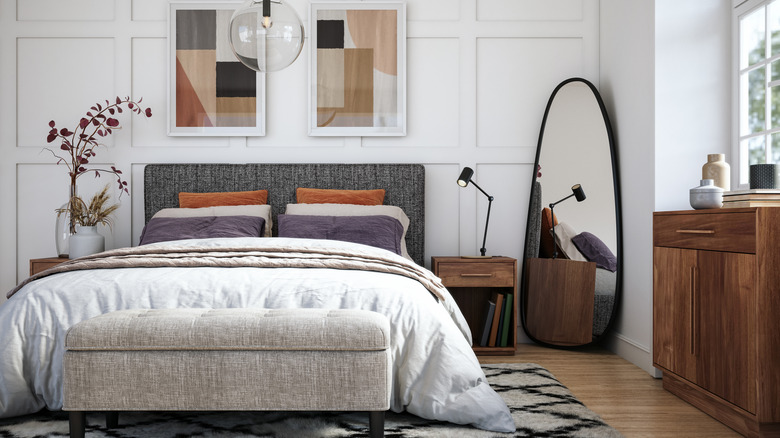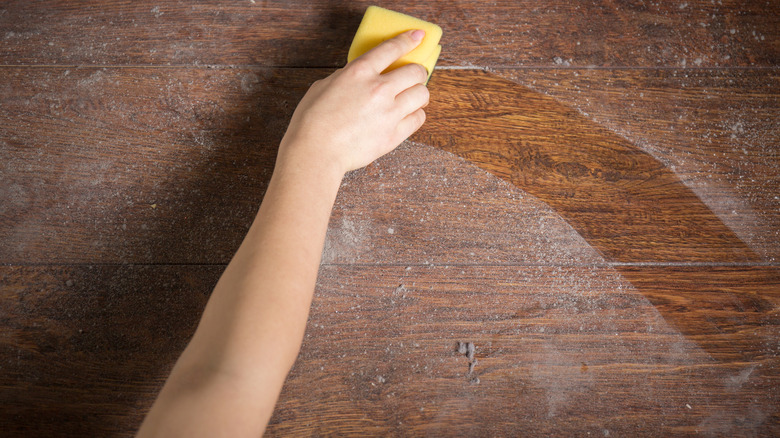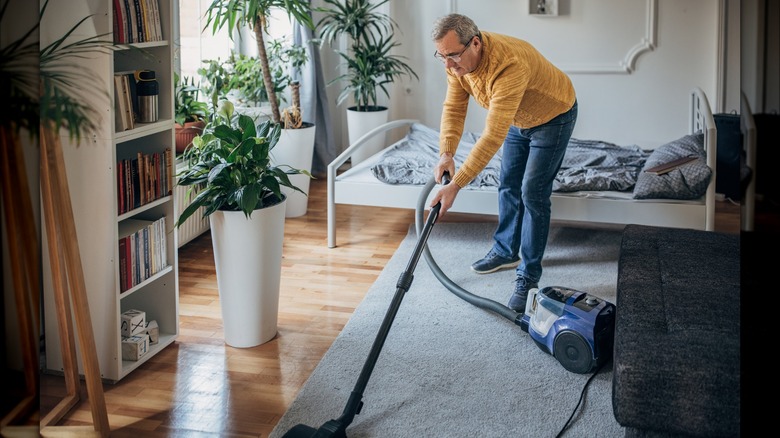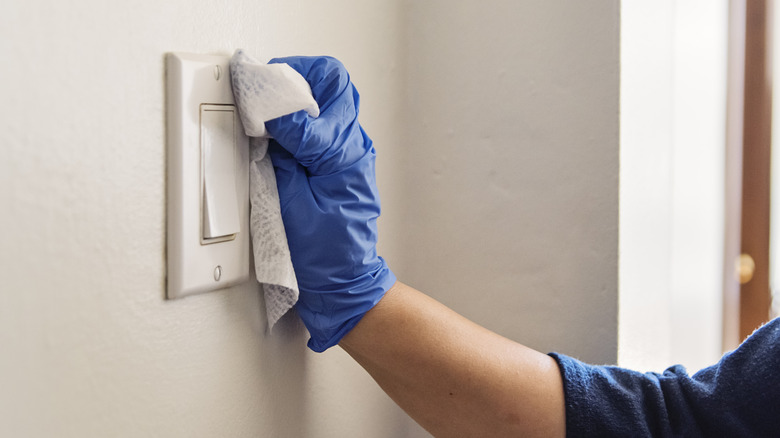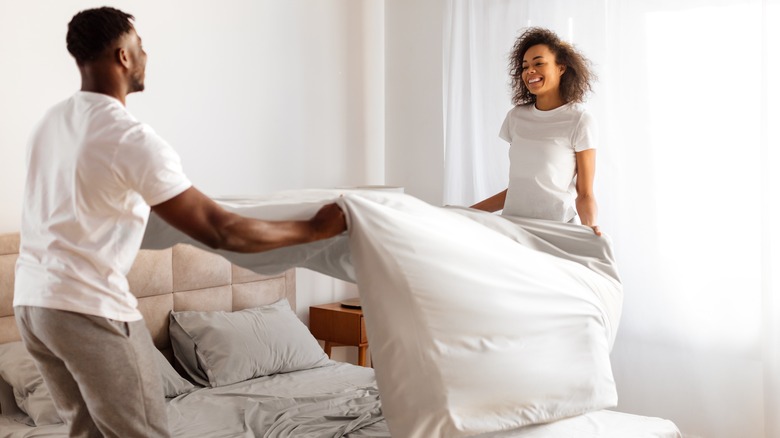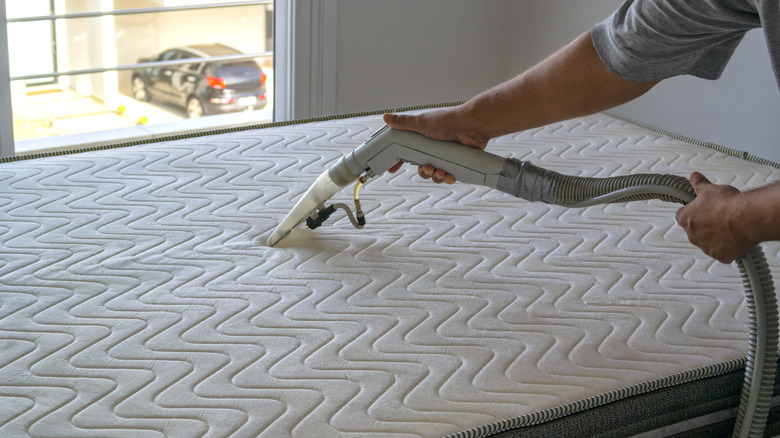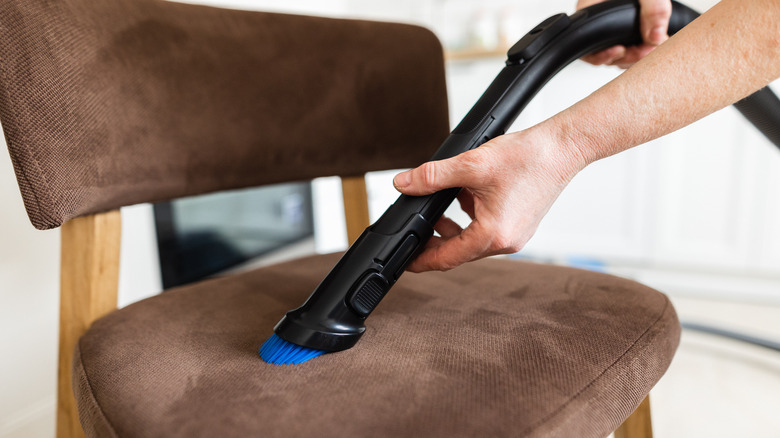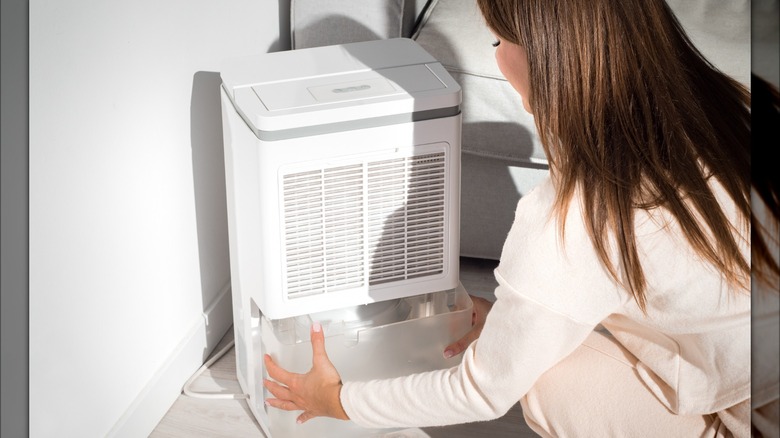8 Things In Your Bedroom You Should Be Cleaning Weekly
We may receive a commission on purchases made from links.
We spend a lot of time in our bedrooms. In fact, if you're an adult and getting the seven to nine hours of sleep recommended by the National Sleep Foundation, that means that you spend about 1/3 of each day in the bed. If you do other activities in your bedroom, such as watching television or working, then you're spending even more time there. When you consider this statistic, the importance of keeping your bedroom clean becomes even clearer.
Sleep Advisor notes some essential elements for creating the ideal sleep environment. Beyond a cool, dark, and quiet space, they share the importance of air quality. Poor air quality with too much dust or other contaminants can irritate your body or even cause symptoms such as coughing, trouble breathing, or headaches. See which key things in your bedroom you should be cleaning weekly to promote a healthy space for better sleep and the ability to enjoy other activities.
Dust the furniture every week
Carve aside some time to dust the furniture in your bedroom at least once a week. Dusting your furniture weekly will do more than just make it look cleaner. It will help remove the potentially harmful dust from your space. Dust can be made of various particles, most commonly hair, dead skin, and dander. However, dust can also hold lead, asbestos, flame retardants, and other potentially toxic chemicals. With regular dusting, these contaminants are removed from your bedroom, alleviating the respiratory symptoms which they may cause, along with any other potential complications caused by exposure to any toxic chemicals.
Before dusting any of the furniture in your bedroom, start by clearing the surface. Remove any books, jewelry boxes, electronics, and other items. Trying to "dust around" these things won't be as effective for removing all the contaminants. Then, wipe down the surface using a microfiber dusting cloth, such as any of these available on Amazon. These cloths are electrostatically charged and will hold onto the dust instead of releasing it back into the air. Before returning any items to the freshly dusted surface, be sure to wipe them down using another dusting cloth.
Vacuum or mop to keep the floors clean and free of dust and allergens
The floors in your bedroom should also be cleaned every week to help create a dust-free environment that won't irritate allergy or asthma symptoms. A minimum of once-weekly vacuuming can reduce the amount of dust and dander in the space. A HEPA filter-equipped vacuum can prevent throwing dust back into the air as you clean.
Beyond the health benefits of regular vacuuming, it can also help protect your carpeting. The Carpet and Rug Institute draws a parallel between vacuum and oil changes. In the same way that regular oil changes are an integral part of car maintenance, vacuuming is an essential component of maintaining a carpet. By removing trapped-in dirt and other debris, it protects the fibers and helps the carpet last longer. Remember to vacuum after you've finished dusting to eliminate the need to vacuum again after knocking dust to the floor.
Wipe down doorknobs and light switches to get rid of germs and bacteria
Doorknobs and light switches are two surfaces that are often overlooked when cleaning. However, if you stop to think about it, it should be clear that these are actually two of the most important surfaces to clean regularly. Nearly every time someone enters or leaves a room, they handle the doorknob and the light switch, potentially covering them with germs and bacteria. These high-touch surfaces can spread bacteria that cause viruses, such as colds, E. coli, and the flu. You may want to clean these surfaces more often, at least two times a week. If you can't keep up with that frequency, don't let them go longer than one week between cleanings.
Viruses can stay active longer on hard surfaces, like doorknobs and light switches. With proper protocols, disinfecting can remove the germs. Just remember to read the directions on the disinfectant you use. Many require the surface to remain wet for 10 minutes before it is wiped down. Failure to follow these directions could leave behind some germs and bacteria.
Wash your sheets at least once a week, especially if you sleep with pets
We get it. Stripping the sheets and remaking the bed is a chore. Literally. However, regardless of how you feel about this time-consuming task, it is one that should be done frequently. The reason? Between dead skin cells, bacteria, and dust mites, our sheets can get dirty quickly. The longer they go between washes, the more gunk you'll be sharing the bed with, potentially impacting your overall health or sleep quality.
If you're wondering how often you should wash your bedsheets, as a general rule, don't let more than two weeks go by between washes. However, if you have pets that sleep with you or you live in a warm climate, you'll want to strip your bed and launder the sheets about once a week. Pet dander has the potential to cause ringworm, scabies, and other infections, hence the need for more frequent washings. Other symptoms that can be caused by not washing your sheets regularly enough include allergy flareups, breathing problems, and eczema.
Clean the mattress after stripping the sheets
When you have finished stripping the sheets, there is one thing you'll want to do before remaking the bed: Clean your mattress. Before starting to clean the mattress, consult the manufacturer's recommendations. Some recommend certain cleaning methods or advise against others. Following these guidelines can help prevent accidental damage and help your mattress last longer.
Vacuuming your mattress weekly can help further reduce the presence of dust in the bedroom, keeping allergy and asthma symptoms under control. In addition to weekly vacuuming, you should also address any stains you see. Removing stains immediately is important to protect the mattress and prevent stains from setting in. Dip a microfiber cloth in a solution of warm water and a few drops of gentle dish soap. Use the cloth to dab the stain until you've removed as much as possible. After vacuuming and spot-cleaning the mattress, let it air out before making the bed so that it has time to dry fully.
You can give your mattress a deeper cleaning about once every six months. To do so, follow the same routine shared above to vacuum the mattress and address any stains. Next, sprinkle baking soda over the surface, adding a little extra over any remaining stains. Let the baking soda remain on the mattress for two hours, ideally with the windows open to promote better air circulation. Then, vacuum the baking soda off the mattress, flip it over, and repeat all the steps to deep clean the other side.
Vacuum upholstered furniture every week
As you're thinking about surfaces in your bedroom that can collect dust, dander, and other debris, you shouldn't overlook upholstered furniture. If you have any chairs, benches, or other covered furniture pieces in your space, then you will want to add vacuuming them to your weekly cleaning list. Because dust can cause all sorts of problems on its own, with the potential of toxic chemicals being present, it is even more important to keep it out of your spaces. Using a vacuum cleaner with a HEPA filter is the best way to effectively remove these contaminants and stop them from spreading back into the room.
If you have pets, particularly any that shed, your upholstered furniture may also get covered with fur. If you find that your vacuum cleaner attachments aren't quite pulling up all the hair, try using a pet hair removal rake, like this one from Soccso. The fabric shaver will pull fur out of the upholstery without damaging it (though it is always a good idea to test it in an inconspicuous location first).
Remove pet hair from area rugs using a rubber rake
If you have cats or dogs that spend time in your bedroom, chances are their shed fur is covering many of the surfaces. One such surface is your area rugs. As an experienced pet owner, you probably already know that vacuuming isn't always enough to get rid of all the shed hair. Instead of relying on a vacuum alone, try using a rubber rake first to pull out as much of the fur as possible. Rubber rakes, such as the Homilifibra Rubber Broom with Squeegee, can pull out hair that is trapped in the rub fibers. The broom has rubber bristles that are able to get deeper into the fibers and act like a magnet to pull out fur and other debris.
According to the Asthma and Allergy Foundation of America, pet allergies (which affect 10-20% of people around the world) are caused by pet dander, which collects on the fur of the animal. Eliminating as much of this hair from your space, combined with other methods, such as using an air purifier, can help reduce allergy symptoms.
Clean humidifiers and dehumidifiers to prevent mold growth
If you use a humidifier or dehumidifier in your bedroom to manage moisture levels, it is important to clean it out every week. Because these devices hold so much water — whether they are pulling it out of or sending it into the air — mold or mildew can grow quickly if the appliances are not kept clean. The EPA recommends cleaning portable humidifiers even more frequently, about once every three days, to prevent microorganisms and scale from accumulating. Keeping humidifiers clean can prevent the hazardous microorganisms from being sent into the air, where they could cause breathing issues and other problems. Ultrasonic and cool mist (impeller) humidifiers are the two types that the EPA cites as the most likely to disperse microorganisms and minerals into the air without proper cleaning.
Consult the manufacturer's recommendations on how to clean your humidifier or dehumidifier. After emptying all water from the device, take it apart and clean each component using a solution of equal parts vinegar and water. You'll need a cleaning brush or two, such as the OXO Good Grips Deep Clean Brush Set, to help you scrub the various components.
